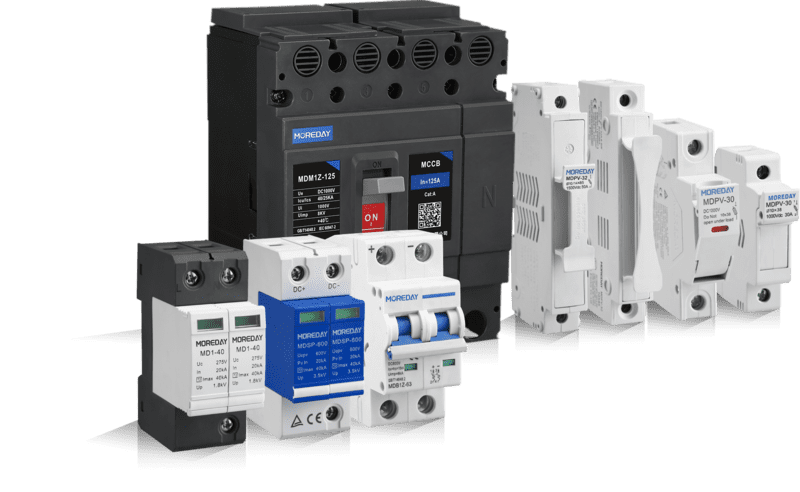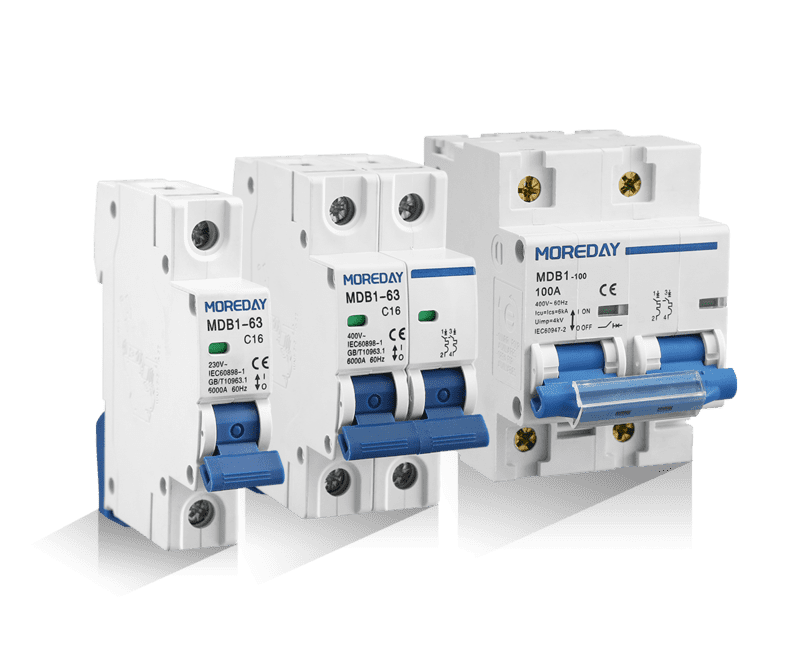Circuit breakers are important safety devices used in every modern electrical system. It is designed to automatically shut down power when a circuit is overloaded or shorted, preventing damage to equipment, wiring, and most importantly, fire hazards. This article will delve into its use in our daily lives to fully understand its significance.
What Is a Circuit Breaker
A circuit breaker is an automatic electrical switch designed to protect an electrical circuit from damage by overcurrent caused by overload or short circuits. Its basic function is to interrupt the flow of electricity after detecting a fault condition, and the circuit breaker can be reset (manually or automatically) to resume normal operation.
Circuit breakers are essential for providing overcurrent protection and ensuring electrical safety in residential, commercial and industrial environments.
What Is a Circuit Breaker Used For?
Circuit breaker uses include:
- Overload protection: When the current in the circuit exceeds a safe level, the circuit breaker will automatically cut off the power supply to prevent wire overheating and fire.
- Short circuit protection: When a short circuit occurs, that is, when the current increases abnormally and flows in an unintended path, the circuit breaker will quickly disconnect the circuit to prevent damage to electrical equipment and other safety risks.
- Circuit Control: The circuit breaker can be manually operated to cut off the circuit during maintenance or inspection safely.
- Reusability: Unlike disposable fuses, circuit breakers can be reset and reused after tripping, providing a cost-effective electrical safety management solution.
How Does a Circuit Breaker Work?
A circuit breaker works by automatically cutting off power when it detects an overload, short circuit, or other electrical fault in a circuit. The core mechanism usually involves a bimetallic strip that is heated and bent under excessive current or an electromagnet that is activated due to a high current surge.
In both cases, movement either trips the switch, opens the circuit, or directly opens the electrical contacts, thus stopping the flow of electricity. This action prevents potential damage to the electrical system and reduces the risk of fire, allowing for a safe manual reset and restoration of power once the problem is resolved.
Circuit Breaker Types

Each type of circuit breaker is designed for specific applications, fault detection capabilities, and load-handling characteristics. Here are some common circuit breakers:
1. Standard circuit breaker
Single-pole circuit breaker: For use on standard 120-volt circuits, common in residential applications. They protect an energized wire and provide 15 to 50 amps of power.
Double-pole circuit breakers: Designed for use on 240-volt circuits, double-pole circuit breakers control two wires and provide up to 200 amps of power. They are commonly used in major appliances such as dryers, water heaters, and air conditioners.
2. Ground Fault Circuit Interrupter
GFCIs are designed to prevent electrical shock, especially in wet environments such as bathrooms, kitchens and outdoor areas. If a ground fault or leakage current is detected, they quickly shut down power, often within milliseconds, significantly increasing safety.
3. Arc Fault Circuit Interrupter
AFCI is primarily used to prevent electrical fires caused by wiring errors and arc faults. They detect unexpected arcs and disconnect power to prevent fires. According to modern electrical codes, they are increasingly common in residential electrical systems.
4. Combination Arc Fault Circuit Interrupter
Combination AFCI protects against series and parallel arc conditions, providing broader protection than standard AFCI. They are useful in residential environments where wiring connections can degrade over time, increasing the risk of arcing.
5. Molded Case Circuit Breaker
MCCB is more rugged and used in commercial and industrial environments to provide higher current and fault protection. They typically offer adjustable travel settings and can handle up to 2500 amps for higher power applications.
6. Motor protection circuit breaker
These circuit breakers are specifically designed to protect electric motors from overloads and short circuits. They often include thermal and magnetic protection tailored to the specific starting and operating characteristics of the motor.
7. Miniature Circuit Breaker
MCB is mainly used in lower-load applications. They are smaller and typically used where space and lower power consumption are a concern, such as in residential or light commercial environments.
Each type of circuit breaker is designed to provide specific protection in different electrical system configurations, ensuring safety for a variety of electrical load requirements and applications.
MCB is divided into AC and DC MCB. Understand the differences between them to choose the appropriate MCB.
How to Choose a Circuit Breaker

Choosing the correct circuit breaker can effectively improve and ensure electrical safety and efficiency. The following are key factors to consider when selecting a circuit breaker:
1. Understand Your Requirements
- Circuit Voltage and Current: Determine the voltage and current requirements of the circuit. Choose a circuit breaker that matches or exceeds these specifications to handle the electrical load safely.
- Type of Load: Identify whether the load is resistive (like heaters) or inductive (like motors), as this affects the type of breaker needed.
2. Select the Appropriate Type
- Standard, GFCI, AFCI, or CAFCI: Choose between standard circuit breakers, Ground Fault Circuit Interrupters (GFCI), Arc Fault Circuit Interrupters (AFCI), or Combination AFCIs based on the specific needs and local code requirements.
- Thermal-magnetic or Electronic: Decide if a thermal-magnetic breaker (for general applications) or an electronic breaker (for precise control and settings) is suitable.
3. Check Interrupting Capacity
- Safety Margin: Ensure the breaker’s interrupting capacity is higher than the maximum calculated short-circuit current at its location in the circuit. This is critical to prevent the breaker from failing to operate during an actual fault.
4. Consider Physical and Installation Constraints
- Size and Mounting: Check the physical size of the breaker and the available space in your panelboard. Ensure compatibility with the mounting type (bolt-on, plug-in, rail-mount).
- Number of Poles: Determine if you need a single-pole, double-pole, or three-pole breaker depending on the number of phases and the type of connection needed.
5. Review Environmental and Operational Conditions
- Environmental Factors: For environments with high moisture, dust, or chemicals, consider breakers with higher environmental ratings or protective casings.
- Operating Temperature: Check the operating temperature range of the breaker and ensure it matches the environmental conditions where it will be installed.
6. Compliance with Standards and Regulations
- Local Codes and Standards: Ensure the breaker meets local electrical codes and standards such as the National Electrical Code (NEC) in the U.S. This includes specific requirements for types of breakers in certain locations (like GFCIs in bathrooms and kitchens).
7. Manufacturer and Brand
- Reliability and warranty: Choose a reputable manufacturer with a proven track record of reliability and safety. Consider the warranty and support services offered by the manufacturer.
When choosing a circuit breaker, you must fully consider the above factors and purchase the best circuit breaker for your application.
Conclusion
In summary, circuit breakers play an important role in ensuring safety and preventing damage. It provides critical safety mechanisms to maintain distribution integrity and reliability.
By effectively managing electrical loads and preventing unsafe conditions, circuit breakers maintain essential standards of electrical safety and efficiency that are the foundation of modern life and operations.
Whether you are purchasing a single circuit breaker for your application or purchasing in bulk, you can source your needs on the Moreday website, contact us to get a quote!

